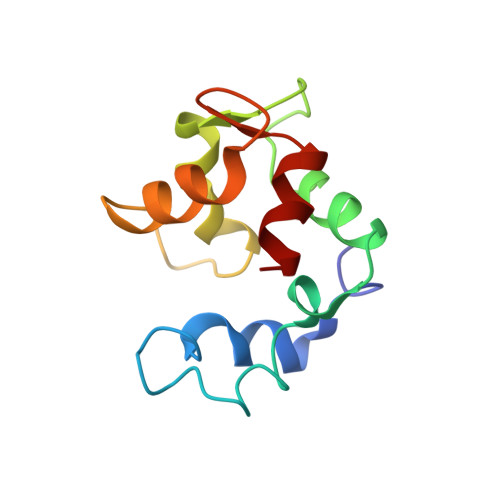Structure of Avian Thymic Hormone, a High-Affinity Avian beta-Parvalbumin, in the Ca(2+)-Free and Ca(2+)-Bound States.
Schuermann, J.P., Tan, A., Tanner, J.J., Henzl, M.T.(2010) J Mol Biol 397: 991-1002
- PubMed: 20156445
- DOI: https://doi.org/10.1016/j.jmb.2010.02.014
- Primary Citation of Related Structures:
2KQY, 3FS7 - PubMed Abstract:
Originally isolated on the basis of its capacity to stimulate T-cell maturation and proliferation, avian thymic hormone (ATH) is nevertheless a parvalbumin, one of two beta-lineage isoforms expressed in birds. We recently learned that addition of Ca(2+)-free ATH to a solution of 8-anilinonaphthalene-1-sulfonate (ANS) markedly increases ANS emission. This behavior, not observed in the presence of Ca(2+), suggests that apolar surface area buried in the Ca(2+)-bound state becomes solvent accessible upon Ca(2+) removal. In order to elucidate the conformational alterations that accompany Ca(2+) binding, we have obtained the solution structure of the Ca(2+)-free protein using NMR spectroscopy and compared it to the Ca(2+)-loaded protein, solved by X-ray crystallography. Although the metal-ion-binding (CD-EF) domains are largely coincident in the superimposed structures, a major difference is observed in the AB domains. The tight association of helix B with the E and F helices in the Ca(2+)-bound state is lost upon removal of Ca(2+), producing a deep hydrophobic cavity. The B helix also undergoes substantial rotation, exposing the side chains of F24, Y26, F29, and F30 to solvent. Presumably, the increase in ANS emission observed in the presence of unliganded ATH reflects the interaction of these hydrophobic residues with the fluorescent probe. The increased solvent exposure of apolar surface area in the Ca(2+)-free protein is consistent with previously collected scanning calorimetry data, which indicated an unusually low change in heat capacity upon thermal denaturation. The Ca(2+)-free structure also provides added insight into the magnitude of ligation-linked conformational alteration compatible with a high-affinity metal-ion-binding signature. The exposure of substantial apolar surface area suggests the intriguing possibility that ATH could function as a reverse Ca(2+) sensor.
Organizational Affiliation:
Northeastern Collaborative Access Team (NE-CAT), Department of Chemistry and Chemical Biology, Cornell University, Ithaca, NY 14853, USA.














